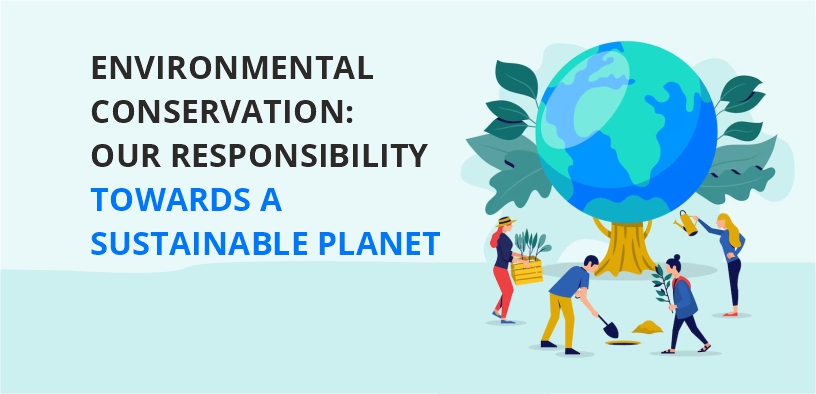The world faces unprecedented challenges today due to the increasing degradation of our environment. As human activities have expanded and grown in complexity, the natural world has borne the brunt of our actions.
However, there is a growing awareness of the need for environmental conservation to ensure a sustainable planet for future generations. Narayan Seva Sansthan, a renowned charitable organization, plays a significant role in promoting environmental conservation and sustainable practices.
1: The Importance of Environmental Conservation
1.1 Preserving Biodiversity: Biodiversity is the variety of life on Earth, including different species of animals, plants, and microorganisms. Conserving biodiversity is crucial because each species plays a unique role in maintaining ecosystem balance. Loss of biodiversity can disrupt the food chain, reduce ecosystem resilience, and lead to long-term negative consequences for humanity.
1.2 Climate Change Mitigation: Environmental conservation helps mitigate climate change by reducing greenhouse gas emissions and preserving carbon sinks like forests and wetlands. Protecting these natural carbon reservoirs is vital in offsetting human-induced emissions and stabilizing the climate.
1.3 Ecosystem Services: Healthy ecosystems provide essential services such as clean air, water purification, pollination, and nutrient cycling. By conserving natural habitats, we ensure the continuity of these services, benefiting both human well-being and the environment.
2: Threats to the Environment
2.1 Deforestation: The widespread clearing of forests for agriculture, logging, and urbanization leads to habitat loss, carbon release, and disrupts the ecological balance.
2.2 Pollution: Air, water, and soil pollution caused by industrial activities, agricultural runoff, and improper waste disposal harm both wildlife and human health.
2.3 Loss of Biodiversity: Human activities, including over-harvesting, habitat destruction, and invasive species, have led to a significant decline in global biodiversity.
2.4 Climate Change: The burning of fossil fuels and deforestation are major contributors to climate change, resulting in rising global temperatures, extreme weather events, and disruptions to ecosystems.
3: Our Responsibilities as Individuals
3.1 Reduce, Reuse, Recycle: Adopting a lifestyle that prioritizes reducing waste, reusing items, and recycling materials can significantly minimize our environmental footprint.
3.2 Energy Conservation: Being mindful of energy consumption and opting for renewable energy sources can reduce greenhouse gas emissions and dependence on fossil fuels.
3.3 Sustainable Consumption: Choosing sustainably sourced products and supporting eco-friendly businesses can drive positive change in the market and promote responsible resource use.
4: Community and Government Roles
4.1 Environmental Education: Communities and governments must prioritize environmental education to raise awareness and empower individuals to make informed decisions.
4.2 Protected Areas and Wildlife Conservation: Establishing and effectively managing protected areas can safeguard critical habitats and preserve biodiversity.
4.3 Policy and Legislation: Governments play a pivotal role in enacting and enforcing environmental regulations and laws to hold industries accountable and promote sustainable practices.
4.4 Supporting Renewable Energy: Governments can encourage the transition to renewable energy sources through incentives, subsidies, and investment in clean energy infrastructure.
5: International Cooperation
5.1 Transboundary Environmental Issues: Collaboration between countries is essential in addressing global environmental challenges that cross national borders, such as air and ocean pollution.
5.2 Climate Agreements: Participation in international agreements like the Paris Agreement helps nations work together to combat climate change on a global scale.
6: Innovative Solutions for Environmental Conservation
6.1 Green Technology: The development and implementation of green technologies can play a significant role in environmental conservation. Advancements in renewable energy, such as solar, wind, and hydropower, reduce carbon emissions and decrease our reliance on fossil fuels. Additionally, investing in energy-efficient appliances, smart grids, and sustainable transportation can further contribute to conservation efforts.
6.2 Sustainable Agriculture: The agricultural sector is a major contributor to environmental degradation through deforestation, chemical use, and soil degradation. Embracing sustainable agricultural practices, such as organic farming, crop rotation, and agroforestry, promotes biodiversity, enhances soil health, and reduces the ecological impact of food production.
6.3 Conservation Finance: Innovative financial mechanisms can incentivize environmental conservation efforts. Payment for Ecosystem Services (PES) programs, where individuals or organizations pay for the ecological services provided by nature, can encourage landowners and communities to protect forests, wetlands, and other valuable habitats.
7: Empowering Local Communities
7.1 Indigenous and Local Knowledge: Indigenous communities often possess traditional knowledge about sustainable resource management and living in harmony with nature. Recognizing and incorporating this wisdom into conservation strategies can enhance the effectiveness of environmental efforts.
7.2 Community-Based Conservation: Involving local communities in conservation initiatives ensures that their needs and concerns are addressed, making conservation efforts more socially and culturally acceptable. Such involvement fosters a sense of ownership and responsibility for the environment.
8: Reversing Environmental Degradation
8.1 Reforestation and Afforestation: Planting trees and restoring degraded forests help sequester carbon, combat deforestation, and create habitats for wildlife. Reforestation efforts can also contribute to climate change mitigation and enhance ecosystem resilience.
8.2 Ocean Conservation: Protecting marine ecosystems, establishing marine protected areas, and reducing plastic pollution are vital for preserving marine biodiversity and the health of our oceans.
8.3 Wetland Restoration: Restoring wetlands aids in flood control, water purification, and the support of numerous plant and animal species. It is crucial to safeguard these essential ecosystems.
9: The Role of Businesses and Corporations
9.1 Corporate Social Responsibility (CSR): Companies can integrate environmental conservation into their business practices through CSR initiatives. Committing to sustainable sourcing, reducing emissions, and supporting environmental projects can help corporations contribute positively to the planet.
9.2 Circular Economy: Transitioning to a circular economy, where products are designed to be reused, recycled, or repurposed, can significantly reduce waste and limit resource depletion.
10: Overcoming Challenges in Environmental Conservation
10.1 Political Will: Despite widespread recognition of environmental issues, political willpower to implement necessary changes can sometimes be lacking. Advocacy and public pressure can play a critical role in encouraging leaders to prioritize environmental conservation.
10.2 Global Collaboration: Strengthening international cooperation and forging partnerships between governments, NGOs, and businesses is essential to address transboundary environmental challenges effectively.
Conclusion
Environmental conservation is an urgent global priority that requires immediate and sustained action. Narayan Seva Sansthan sets an inspiring example of how a charitable organization can extend its reach beyond disability rehabilitation and actively contribute to environmental preservation.
By advocating for sustainable practices, promoting renewable energy, and collaborating with various stakeholders, they showcase the significance of collective efforts in building a sustainable planet. As individuals, it is also our responsibility to support such initiatives and work together towards a greener, healthier future for all.








